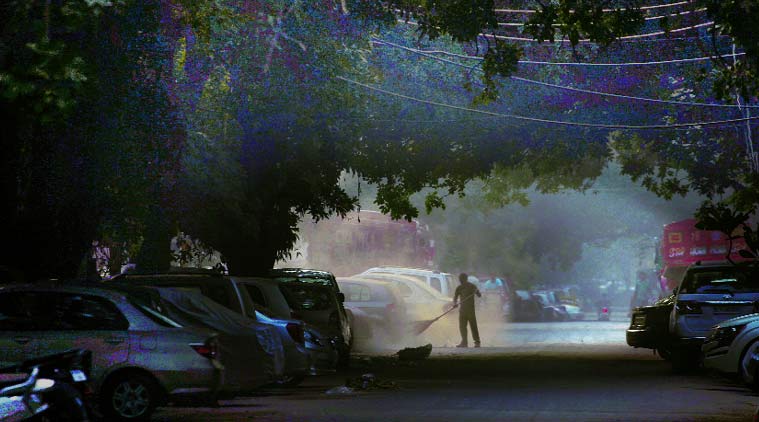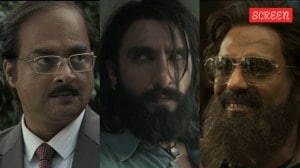Stay updated with the latest - Click here to follow us on Instagram
Municipal Corporation of Delhi: Blank Balance
Trifurcation of erstwhile MCD of Delhi in 2012 left two of its arms in a state of perpetual financial crisis.
 One of the 30 unauthorised colonies in East Delhi which do not pay property tax. (Source: Express Photo)
One of the 30 unauthorised colonies in East Delhi which do not pay property tax. (Source: Express Photo)
The trifurcation of the erstwhile Municipal Corporation of Delhi in 2012 left two of its arms in a state of perpetual financial crisis. Meanwhile, the South corporation fared much better and has not depended on grants for the last three years. Shalini Narayan and Aditi Vatsa find what causes the disparity in the civic bodies’ balance sheets
Split cost East civic body dearly
With the East Municipal Corporation running into losses worth Rs 500 crore annually, East Delhi Mayor Meenakshi, on Monday, alleged that the newly elected Delhi government has not paid heed to requests made by the corporation to look into its financial crisis.
Claiming that she had been urging the Chief Minister’s office for an appointment with Arvind Kejriwal since February 16, Meenakshi alleged that the government was not realising the “urgency of the situation”.
“Because of financial woes, the East corporation has not been able to pay salaries to its staff and pension to its retired employees for the previous month,” she said.
[related-post]
“East corporation is dependent on funds from the Delhi government for its function and therefore it is the duty of the chief minister to resolve the matter at the earliest,” she said in a statement released by the corporation.
Before the AAP government came to power in Delhi, corporation officials had approached the Lieutenant-Governor as well as Union Home Minister Rajnath Singh, urging them to bail the corporation out.
The East civic body’s situation is very similar to one faced by the North corporation — both have been reeling under financial crisis since 2012, when the erstwhile Municipal Corporation of Delhi was trifurcated.
Officials said while the civic body had been promised an aid of Rs 335 crore to compensate for the financial losses, the amount was given to them only as a loan amount.
Standing Committee chairperson B B Tyagi said, “The government, at the time of trifurcation, had said the corporation would receive Rs 421 crore as grant. However, we were given only Rs 325-335 crore as loan.”
Elaborating on the budgetary hurdles the corporation has faced, Tyagi said, “Our monthly expenditure is around Rs 100 crore. This amounts to Rs 1,200 crore annually. The revenue generated every year, however, is just Rs 700-750 crore.”
Moreover, officials pointed out that even as property tax generation forms an important source of revenue, the areas coming under East civic body are hardly equipped to generate enough revenue.
“There are around 5-6 lakh properties, of which a little over 2 lakh properties pay tax. Moreover, there are at least 30 unauthorised colonies in this zone and we do not collect any property tax from these areas,” Tyagi said.
“The municipal body needed Rs 900 crore in the last four or five months. We have written to the Lt-Governor, the Home Ministry, the Urban Development Minister, but have not received the amount. We have been trying to get an appointment with the Delhi chief minister,” Tyagi said.
 North body: Born on a deficit budget
North body: Born on a deficit budget
For the North Municipal Corporation, the legacy of loans and the effects of trifurcation of the erstwhile Municipal Corporation of Delhi continue to hamper its finances. While the civic body generates nearly Rs 1,400 crore in revenue annually, its annual expenditure is over Rs 2,100 – Rs 2,200 crore — a gap of nearly Rs 1,000 crore.
With the North corporation facing a severe shortage of funds, over 25,000 employees have been left in the lurch. Finance department officials said the civic body was not in a position to provide salaries to 40 per cent of its employees in February. They said the situation is likely to prevail in March if the corporation does not receive aid.
Blaming MCD’s trifurcation for the funds crunch, leader of the House Meera Aggarwal said, “Trifurcation of the MCD in 2012 was done haphazardly. Committees, which were formed on the issue, had pointed out that all revenue sources were going to the South Municipal Corporation. How can there be revenue generation in such conditions? During the trifurcation, it had been clearly stated that such a situation will arise. After trifurcation, the expenses of the North zone increased because of an increase in employee strength and other costs that entail the setting up of a new civic agency.”
Elaborating on the expenditure, a finance department official said, “There are around 715 schools with 3.5 lakh children and five hospitals under the jurisdiction of the North civic body. Around Rs 1,000 – Rs 1,100 crore is spent on healthcare and education. With around 55,000 employees, the total expenditure of the civic body on dispensing salaries comes to around Rs 2,100 crore. The corporation has an additional liability of Rs 250 crore annually. There is a large gap between our sources of revenue and expenditure.”
The situation has worsened further in the last few months with the absence of an elected government in Delhi, officials said.
“For instance, the North corporation is expected to receive Rs 620 crore for education this year. However, with the government falling short of funds, this figure came down to Rs 468 crore. The grants from the Delhi government, which fills in the revenue-expenditure gap also fell short this year,” an official said.
Another source of revenue for the civic body is a basic share through the Delhi government, which is based on formula decided by the Finance Commission. While this amounts to around Rs 302 crore, the municipal body has not received this amount since the trifurcation in 2012.
“It gets adjusted in paying back loans and interest amount that the North corporation owes the Delhi government,” the official said.
Officials said the civic body has had a deficit budget since its inception. But, the situation has improved slightly over the years.
“In 2012-13, the deficit amount was around Rs 1,000 crore. It came down to Rs 960 crore the next year. This year, however, we have not received around Rs 300 crore from the government since only an elected government can dispense this loan,” the official said.
 Hotels such as Taj Mansingh (above) and Le Meridien are one of NDMC’s biggest source of revenue. (Source: Express Archive)
Hotels such as Taj Mansingh (above) and Le Meridien are one of NDMC’s biggest source of revenue. (Source: Express Archive)
Posh markets, 5-star hotels keep NDMC in rude health
The New Delhi Municipal Council (NDMC) has no dearth of funds and it is purportedly the richest civic agency in the country.
Covering a small area of 42.74 square kilometre, the NDMC territory comprises Lutyens Delhi, Rashtrapati Bhawan, North and South Block, the Supreme Court, Parliament House. Incidentally, it also includes most of Delhi’s five-star hotels, market places and office buildings.
“The rent generated from our assets are substantial to take care of the expenses. The Chandralok Building, Taj Mansingh hotel, Le Meridien in Chanakyapuri — there is no dearth of revenue sources,” an official said.
According to the civic body’s estimates, the revenue generation graph has seen a consistent increase over the years. As opposed to a revenue receipt of Rs 1,944.61 crore in 2011-12, the council had estimated an increased revenue receipt of Rs 2,214.56 crore in 2012-13. In 2011-12, expenditure amounted to Rs 1,935.70 crore while the estimated figure for 2012-13 was Rs 1,938.05 crore.
NDMC officials pointed out that the revenue surplus has also seen an upward shift — from Rs 8.91 crore in 2011-12 to Rs 276.51 crore in 2012-13. The surplus for 2013-14 was around Rs 335.34 crore.
“Fees and user charges constitute around 45 per cent of NDMC’s funds. The council receives revenue from other sources such as licence fees, tax revenue, external assistance, among others. Moreover, we have a strength of over 13,000 employees belonging to employee groups A to D. Providing salaries to our employees has never been a problem,” the official said.
As far as the expenditure goes, more than 40 per cent goes to providing electricity and education, followed by usual costs for dministration — around 30 per cent for health, sanitation, solid waste management and public works.
 South corporation makes good money from parking fees. (Source: Express Archive)
South corporation makes good money from parking fees. (Source: Express Archive)
MCD’s only self-sufficient progeny
At a time when most of the municipal bodies in the capital are facing a fund crunch, the South Municipal Corporation claims that it is self-sufficient and “not dependent” on the Delhi government for grants.
To support its claim, the civic body quoted figures from its “surplus budget” for the financial year 2015-2016, which has a revenue of Rs 3,948 crore and an expenditure of Rs 3,900 crore.
Speaking to Newsline, public relations officer of South corporation, Mukesh Yadav, said, “For the civic body, revenue generation has never been a problem. We have not depended on government grants for the last three years. In 2012, we had a pending loan of Rs 700 crore, which was brought down to Rs 350 crore. This was managed through revenue generation.”
“The South corporation’s revenues mainly come from property tax, advertisements, parking charges and building rent. When the government introduced regularisation of farmhouses, that itself augmented the revenue collection by nearly Rs 300 crore. There has been a budget surplus for the last three years,” Yadav said.
According to officials of the South civic body, the trifurcation of the Municipal Corporation of Delhi under the Sheila Dikshit government was opposed by civic body employees on the grounds that equitable distribution of funds across the corporations would not work and that at least one corporation would run into a deficit.
“It was clear that while one corporation would remain poor, the other would be slightly better off, and the third would be the richest. This is exactly how it has turned out. While East corporation remains the poorest, North corporation is slightly better off and South corporation has the most funds. If we had remained as one body, funds would not have been an issue. The Delhi government had promised to help irrespective of the fund crunch. However, the corporations are in debt,” Standing Committee chairperson Subhash Arya said.
In fact, in 2012, the South corporation, comprising 40,000 employees, had issued a policy decision to make itself a “loan-free corporation in the next five years”.
For the civic body now, the only issues that remain are formulation of policies which fall under the Delhi government.
“There are issues of revising scheduled taxes, such as the theatre tax, which still follows the rates fixed in 1970. With increased multiplexes, the rates should have increased. Other issues include one-time parking charges, sanitation byelaws and other minor taxation policies that need to be revised,” a corporation official said.







